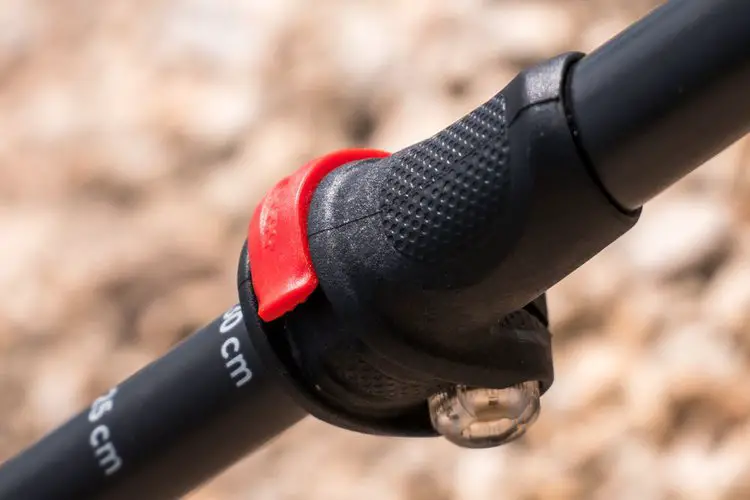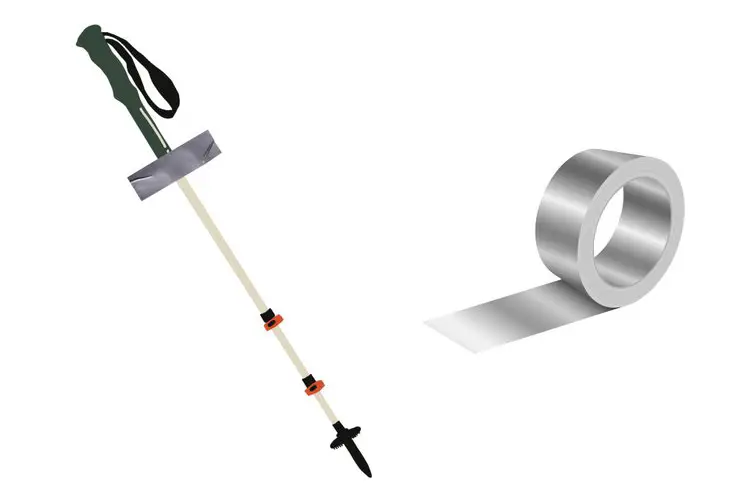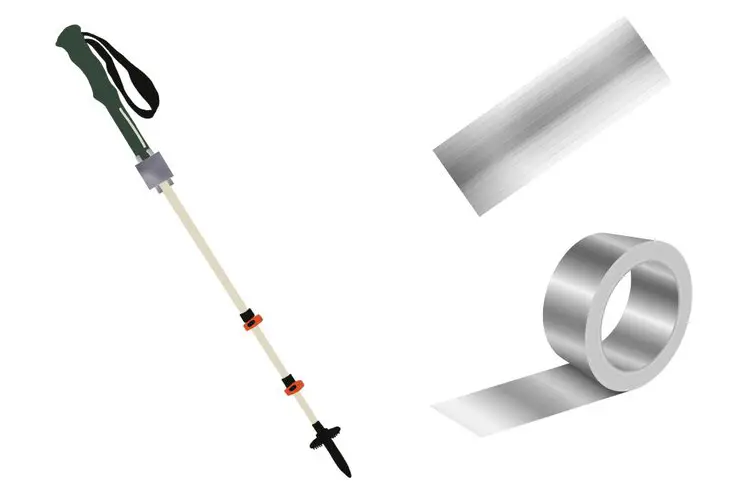Hiking poles are an essential tool for hikers. They provide balance, stability, and support hikers on rugged terrain.
However, over time, hiking poles can become over-extended, which can compromise their strength and effectiveness.
In this article, we’ll explore the reasons why hiking poles become over-extended, their risks, and the methods you can use to fix this problem.
Contents
There are several reasons why hiking poles become over-extended:
Overuse: If you use your hiking poles frequently or on particularly rugged terrain, they may become over-extended over time.
Incorrect Adjustment: If you’ve adjusted your hiking pole incorrectly or not tightened the locking mechanism enough, you may expand it excessively.
Impact: If you’ve dropped your hiking pole or it has taken a hard impact, it may become over-extended.
Risks Associated with Using an Over-Extended Hiking Pole

Using an over-extended hiking pole can pose several risks:
Reduced Stability: An over-extended hiking pole may not provide the stability and support you need, which can increase the risk of falls and injuries.
Structural Damage: Over-extended hiking poles may be weaker and more prone to damage, which affect their structure and quality.
Pain and Discomfort: Using a hiking pole that is expanded too much can cause pain and discomfort in your hands, wrists, and arms, as you’ll have to adjust your grip to compensate for the added length.
Still on the trails? Here are a few tips for temporarily fixing the issue on the trails
Adjust lock mechanism

First, locate the lock mechanism on your hiking pole and loosen it.
Then, adjust the pole to the desired length, making sure it’s level with the ground when held upright.
Finally, tighten the lock mechanism firmly, making sure the pole is secure.
- Pros: This method is simple and easy to do, and doesn’t require any additional tools or materials.
- Cons: If the pole is over-extended due to damage or wear and tear, this method may not be effective.
Use a Duct Tape

If you’re on the trail and don’t have access to other materials or tools, duct tape can be used as a temporary fix for over-extended hiking poles.
To use duct tape, first, remove any excess material from the bottom of the pole.
Then, wrap duct tape around the pole at the desired length, making sure it’s tight and secure.
- 【Strong Strength and Adhesion】The heavy duty duct tape are made with an incredibly strong...
- 【Excllent Ductility】The flexible duct tape conforms to uneven surfaces especially for repairing...
- 【Easily Tear by Hand】The duct tape doesn't need scissors or a dispenser to be cut, making it...
Last update on 2023-11-10 / Affiliate links / Images from Amazon Product Advertising API
- Pros: This method can be effective as a temporary fix, and duct tape is readily available and easy to carry.
- Cons: Duct tape is not a permanent solution and may not hold up well over extended periods of use. It’s important to have the pole properly fixed as soon as possible.
Adjust your grip

Sometimes, simply adjusting your grip on the pole can help alleviate some of the strain on the over-extended section.
You can try gripping the pole further down the shaft or even switch to a single-pole technique.
- Pros: This method is easy and doesn’t require any tools or equipment.
- Cons: It may not work if the pole is severely over-extended, and it may not be a long-term solution if the pole is prone to over-extension.
Use a splint
If the over-extension is severe, you can try using a splint to temporarily stabilize the damaged section of the pole.
To do this, you will need a splint, which can be made from a variety of materials including tent poles, aluminum strips, or even sturdy sticks.
- 4 FT - 1" X 1/16" FLAT BAR
- Easy to Clean and Paint
- Rust Resistant, anodized is rust resistant unlike mill finish
Last update on 2023-11-10 / Affiliate links / Images from Amazon Product Advertising API
Here are the steps to follow:
Step 1: Find a suitable splint
Look for a sturdy and straight object that is slightly smaller in diameter than the pole. Tent poles or aluminum strips work well for this purpose.
Step 2: Cut the splint to size
Measure the length of the over-extended section of the pole and cut the splint to the same length.
Step 3: Place the splint
Place the splint next to the over-extended area of the pole. Make sure it is straight and aligned with the pole.
Step 4: Secure the splint
Use duct tape or other strong tape to securely attach the splint to the pole.
Start by wrapping the tape tightly around the top of the splint and the pole, then work your way down the length of the splint.
Make sure the tape is wrapped tightly and evenly.

Step 5: Test the pole
Once the splint is securely in place, test the pole to make sure it is stable and strong.
If the pole is still wobbly or unstable, you may need to add more tape or adjust the splint.
- Pros
Using a splint is a quick and easy way to fix an over-extended hiking pole, especially if you don’t have access to other tools or materials.
It can be done on the trail without having to take the pole apart.
- Cons
The splint may add some extra weight and bulk to the pole, which could be a concern for some hikers.
If the splint is not attached securely, it could come loose and fail to support the pole properly.
Methods to Fix an Over-Extended Hiking Pole (when you got home):
While there are a number of effective methods for fixing an over-extended hiking pole, it’s worth noting that some approaches may work better than others depending on the specific situation.

For example, if the pole has only been slightly over-extended, it may be possible to simply adjust the locking mechanism or tighten a few screws to get it back into working order.
However, if the pole is significantly bent or warped, more intensive techniques may be required.
As always, it’s important to exercise caution when attempting to fix a hiking pole, particularly if you’re not experienced with the process.
You don’t want to accidentally make the problem worse or damage the pole beyond repair. That said, with the right tools, techniques, and a little bit of know-how, you can often get your hiking pole back into top shape in no time.
Remember, prevention is often the best cure when it comes to over-extension. Regularly inspecting and maintaining your hiking poles, taking caution when adjusting their length, and storing them properly can all go a long way in preventing this issue from occurring in the first place.
And if you do find yourself with an over-extended hiking pole, don’t panic – with the tips and techniques outlined in this article, you should be well on your way to fixing the problem and hitting the trails once again.
Trim the Excess

First, measure and mark the correct length for the hiking pole.
Then, use a hacksaw or pipe cutter to carefully remove the excess material from the bottom of the pole.
Finally, smooth the edges of the cut with sandpaper.
Last update on 2023-11-10 / Affiliate links / Images from Amazon Product Advertising API
As a general rule of thumb, the pole should be adjusted so that the hiker’s arm forms a 90-degree angle at the elbow when the pole is held upright with the tip on the ground.

To determine the appropriate length to trim, start by adjusting the pole to the desired height and marking the spot where it needs to be cut.
Then, remove the pole tip and measure the distance from the bottom of the pole to the cut mark. This will give you the amount of excess material that needs to be trimmed.
- Pros: This method is effective for poles that are over-extended due to wear and tear, and doesn’t require any additional materials.
- Cons: If the excess material is not removed evenly, it can affect the strength and stability of the pole. Also, this method may not work for poles that are over-extended due to damage or incorrect adjustment.
Replace the Lock Mechanism
If the lock mechanism on your hiking pole is worn or damaged, it may not be able to hold the pole at the desired length.

In this case, replacing the lock mechanism can be an effective solution.
To replace the lock mechanism, first, remove the old mechanism from the pole.
Then, choose a new lock mechanism that is compatible with your pole and install it according to the manufacturer’s instructions.
If you need to replace the lock mechanism on your hiking pole, the first step is to determine the brand and model of your pole. This information can typically be found on the pole itself or in the product manual.
Once you have this information, you can search online for replacement parts from the manufacturer or from third-party retailers. Many hiking and outdoor stores also carry replacement parts for hiking poles.
When searching for replacement lock mechanisms, be sure to double-check that the part you’re purchasing is compatible with your specific hiking pole model. If you’re unsure, contact the manufacturer or a customer service representative for assistance.
- ?ADJUSTABLE?Using the flip lock, you can easily adjust the hiking poles to a suitable length, making...
- ?COMFORTABLE TO TOUCH?Trekking pole clip adopts non slip treatment, it feels very comfortable, and...
- ?HIGH QUALITY RUBBER?Trekking pole lock is made of high quality rubber, which is very wearable when...
Last update on 2023-11-10 / Affiliate links / Images from Amazon Product Advertising API
- Pros: This method can be effective for poles that are over-extended due to a faulty lock mechanism, and can be done relatively easily at home.
- Cons: It requires a replacement lock mechanism, which may not be readily available in some areas.
Professional Repair

Depending on the extent of the damage, a professional repair shop may recommend replacing the damaged section of the pole or using other repair methods.
- Pros: This method is the most effective for severe damage and ensures the pole is restored to its original strength.
- Cons: It can be expensive and time-consuming, and may not be feasible if you’re on a long hiking trip.
Last words
In conclusion, a hiking pole is an essential tool for hikers, but it’s important to take care of it properly to ensure it lasts for many adventures to come.
If your hiking pole becomes over-extended, don’t panic! There are several methods you can use to fix it and get back on the trails.
By following the tips in this article and being proactive in maintaining your hiking pole, you can enjoy safe and comfortable hiking experiences.
Happy hiking!





